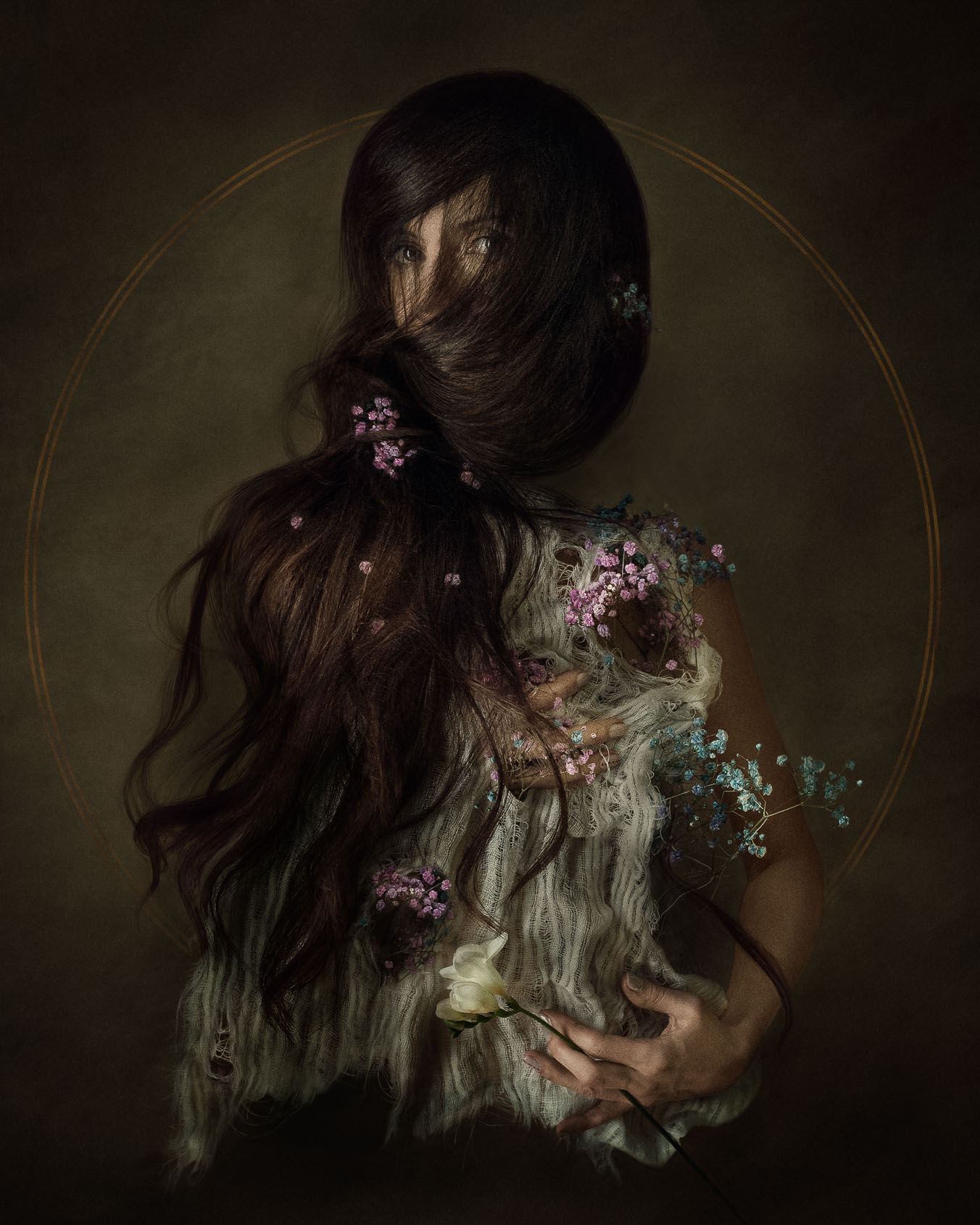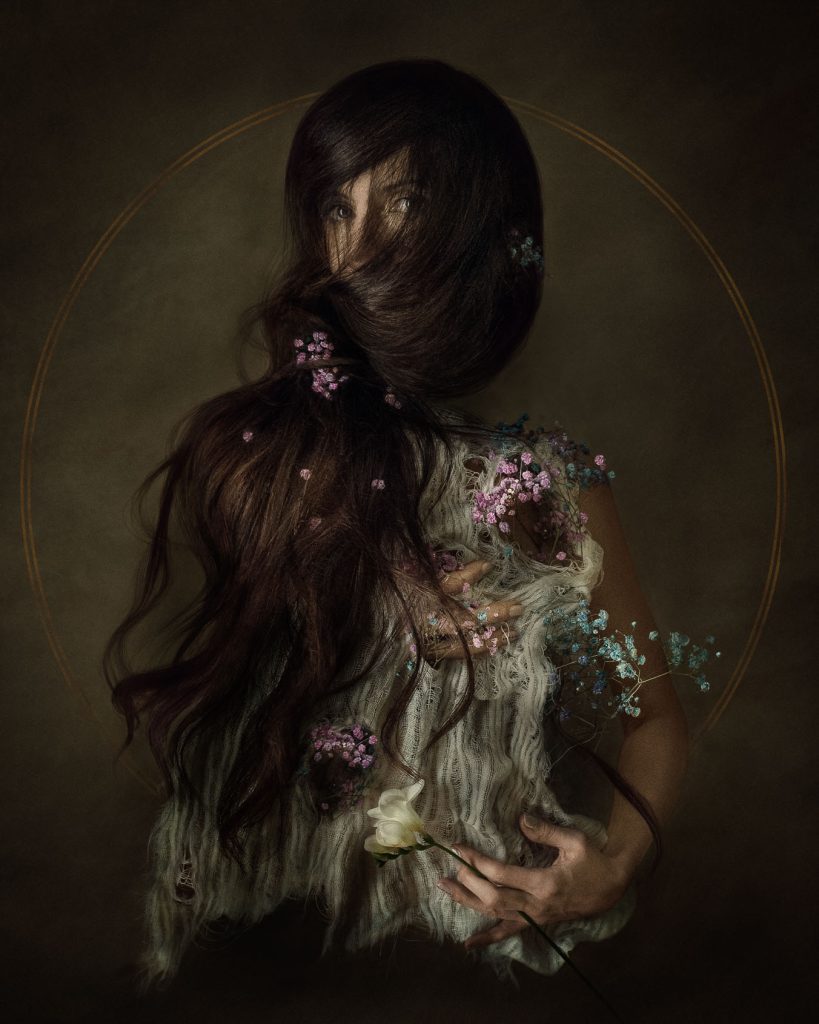
20 Mar Reborn – The first image from the Deconstructing Female Form: Image Analisis
“Reborn” is a compelling exploration of themes such as transformation, renewal, and the mysteries of the female form. The subject’s partially obscured face, hidden behind a veil of cascading hair, adds an element of enigma and introspection, inviting the viewer to ponder the emotional and psychological dimensions of rebirth. The delicate, flowing fabric represents both vulnerability and protection, encapsulating the subject as she undergoes a process of metamorphosis.

Composition:
The composition is characterized by a strong diagonal axis created by the subject’s elongated limbs and the flowing fabric. The subject is positioned off-center, allowing the viewer’s eye to move fluidly through the image, taking in the various elements and negative spaces. The use of the rule of thirds, a classic compositional technique, imparts balance and harmony to the piece. Color: The color palette is predominantly cool and desaturated, with shades of blue and gray dominating the background. This choice of colors imparts a serene and tranquil atmosphere to the scene, emphasizing the dreamlike quality of the composition. The subject’s skin appears luminous, with subtle warm tones contrasting against the cooler background hues, drawing attention to her form and adding a sense of depth to the piece.
Texture and Form:
The image features an interplay of textures and forms, from the soft, flowing fabric to the subject’s smooth skin and the cascading hair. The translucent fabric enveloping the subject creates a sense of intimacy and protection while also adding visual complexity. The fabric’s diaphanous quality contrasts with the subject’s solid form, underscoring the theme of rebirth as a delicate yet transformative process.
Light and Shadow:
The lighting in “Reborn” is subtle yet significant, creating depth and dimension in the image. Soft, diffused light illuminates the subject’s face and body, highlighting her features and lending a sense of volume to her form. The interplay of light and shadow, particularly in the folds of the fabric and the subject’s hair, adds a sense of depth and visual interest to the composition.philosophical concepts and cultural traditions, encouraging contemplation and reflection on the intricacies of the female form, the concept of rebirth, and the transformative power of personal growth. By incorporating elements from both Western and Eastern philosophical thought, “Reborn” fosters a rich and nuanced dialogue that transcends cultural boundaries and invites the viewer to engage with universal human experiences and emotions. Overall, “Reborn” is a visually engaging and thought-provoking work that masterfully employs composition, colour, texture, form, light, and shadow to create a compelling and evocative portrayal of a woman in the midst of a transformative experience. The image, enriched by the philosophical ideas of Jung, Nietzsche, and Eastern traditions, encourages contemplation and reflection on the process of individuation, the cyclical nature of life, and the potential for spiritual growth and enlightenment.
Symbolism and Theme:
“Reborn” is a compelling exploration of themes such as transformation, renewal, and the mysteries of the female form. The subject’s partially obscured face, hidden behind a veil of cascading hair, adds an element of enigma and introspection, inviting the viewer to ponder the emotional and psychological dimensions of rebirth. The delicate, flowing fabric represents both vulnerability and protection, encapsulating the subject as she undergoes a process of metamorphosis.
In the context of the philosophical ideas of Carl Jung, the image can be interpreted as a visual representation of the process of individuation, a journey towards self-discovery and self-realisation. The subject’s obscured face and the dreamlike environment suggest a connection to the unconscious realm, which, according to Jung, is a vital source of personal growth and transformation. The image also evokes the notion of the anima, a Jungian archetype representing the feminine aspect of the male psyche, signifying a reconciliation of opposing forces within the individual.
Additionally, “Reborn” can be seen as a reflection on the cyclical nature of life, drawing upon philosophical ideas from various traditions. The theme of rebirth can be connected to the concept of eternal recurrence in Nietzsche’s philosophy, which posits that life is an endless cycle of creation and destruction, and that individuals must embrace the transformative power of suffering to achieve self-overcoming. The image might also resonate with Eastern philosophies, such as the Hindu belief in the cycle of samsara or the Buddhist concept of rebirth, which emphasise the interconnectedness of life and the potential for spiritual growth and enlightenment.
In relation to Formism, an early 20th-century artistic movement originating in Poland, “Reborn” can be seen as a contemporary response to this movement. Formism was characterised by the use of simplified forms, bold colours, and strong outlines, with the aim of creating art that was both modern and accessible to the public. While “Reborn” might not adhere strictly to the traditional visual language of Formism, it shares a common goal of exploring and breaking down the female form into its constituent parts, thereby challenging conventional perceptions of beauty and femininity.
The image’s symbolism and themes thus invite the viewer to delve deeper into a variety of philosophical concepts, cultural traditions, and art movements, including Formism. Encouraging contemplation and reflection on the intricacies of the female form, the concept of rebirth, and the transformative power of personal growth, “Reborn” fosters a rich and nuanced dialogue that transcends cultural boundaries and invites the viewer to engage with universal human experiences and emotions.
In conclusion, “Reborn” is a visually engaging and thought-provoking work that masterfully employs composition, colour, texture, form, light, and shadow to create a compelling and evocative portrayal of a woman in the midst of a transformative experience. Enriched by the philosophical ideas of Jung, Nietzsche, Eastern traditions, and the artistic movement of Formism, the image encourages contemplation and reflection on the process of individuation, the cyclical nature of life, and the potential for spiritual growth and enlightenment.

No Comments